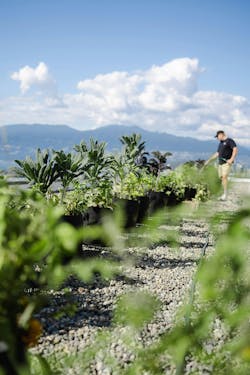Urban Farming: The Next Big Tenant Amenity? (BOMA 2024 Preview)
Finding the top tenant amenities for your building is a tall order for any building owner. The right amenities engage existing tenants and entice new ones, resulting in a fully leased building for the owner. What if your tenant amenities could do both of those things and benefit your community simultaneously?
Meet the urban farm—a sustainable agriculture solution that provides owners with the opportunity to increase tenant engagement, add property value and serve local communities.
MicroHabitat, which has been leading the charge in sustainable urban agriculture since 2016 with more than 250 farms installed, is making its second visit to the BOMA International Conference & Expo in 2024. Operating across 14 locations throughout North America, the Montreal-based company will share its turnkey farming solutions with attendees.
“Our mission is to transform city living by tackling food insecurity and raising environmental awareness,” explained Rose Fox, marketing coordinator for MicroHabitat. “We cultivate 100% chemical-free crops in our lightweight pots, which are suitable for rooftops, terraces and ground spaces. That helps us optimize every inch of urban areas.”
Why Install an Urban Farm?
There are several benefits that commercial building owners stand to reap from having an urban farm. They include:
1. Setting your building apart in the market. “We’ve seen through research that [farms] can help increase property value, as well as community and tenant engagement,” Fox said. “We also offer customized marketing support.”
2. Credits toward building certifications. MicroHabitat can help building owners work toward credits with BOMA BEST, LEED, WELL v2, GRESB and Fitwel, Fox said.
3. Improving sustainability and community service bona fides. “One of the greatest benefits of urban farming is that we’re helping create a better network for pollinators,” Fox said. “We’re also building a better network of food security. The majority of our clients donate their produce back to local food banks and shelters. It feels good to make a positive impact.”
How Do Urban Farms Work?
Most buildings can house an urban farm as long as they have at least 500 square feet to work with, Fox said. This space could be anywhere from your rooftop to your ground level. Properties lacking outdoor space can utilize indoor units, which are suitable for all buildings, according to MicroHabitat. Outdoor installations require at least six hours of sunlight per day, and the MicroHabitat farmer must be able to get to the site and have access to water for the crops.
MicroHabitat typically starts with its proprietary mix of vegetables, herbs and flowers in the first year to obtain a baseline understanding of local soil, climate and site conditions, Fox said. This mix includes root, ground and climbing vegetables, as well as up to 10 types of herbs and several edible flowers. After the first year, clients can request different crops. For example, clients in Texas have been clamoring for more varieties of hot peppers, Fox said.
As the vegetables are harvested, owners have several options for using the produce:
- Donate to a local food bank or shelter privately.
- Donate through MicroHabitat, which maintains its own network of food banks and food-based charities.
- Internal distribution, in which you can set up a farm stand in your lobby or another common area and share your produce with tenants.
- Share produce with on-site restaurants.
In addition to tending the farms, MicroHabitat also makes its farmers available for tenant engagement events. Each of the programs offers a choice of at least two interactive and educational activities, including kiosks, workshops or guided garden visits, designed to enhance understanding and involvement in sustainable urban agriculture. “Our goal is to deepen the connection between individuals, nature and the food they consume,” Fox said.
Check out MicroHabitat and other vendors at the 2024 BOMA International Conference & Expo. Click here to register!
About the Author
Janelle Penny
Editor-in-Chief at BUILDINGS
Janelle Penny has been with BUILDINGS since 2010. She is a two-time FOLIO: Eddie award winner who aims to deliver practical, actionable content for building owners and facilities professionals.


